Chamomile flowers. Growing garden chamomile: all the secrets of planting and caring for the plant.
Many of us love flowers that look like daisies. The first flower I drew in childhood looks exactly like this – a yellow center with petals around the edges. I immediately remember my childhood with the naive fortune-telling “loves or doesn’t love.” Flowers with petals, like those of a chamomile, are charming in their simplicity, pleasing to the eye, unpretentious in care, and look harmonious in flower beds and areas. They are equally good in singles or mixed plantings. However, their colors and sizes can be completely different. Let's look at the most popular of them.
In the flowerbed there are chamomile, garden chamomile and yellow coreopsis
Anacyclus is very easy to confuse with chamomile because they are actually very similar. This flower has approximately 10 varieties and can be either an annual or a perennial. Anacyclus blooms towards the end of May and continues to produce color until late July/early August. This representative of the Asteraceae family reacts to lighting: in the evening the flowers close, and open in the morning. Most often on garden beds Anacyclus depressus can be seen - it is considered the most common species and is grown as a perennial. From the category of annuals, the most favorite (frequently found) are Anacyclus clavatus (club-shaped) and Anacyclus radiatus (radiant). The white petals of anacyclus are colored pink below, which distinguishes it from chamomile. This is a low creeping plant, it has strong pedicels, and the flowers themselves are approximately 5 cm in diameter.
Anacyclus, photo:

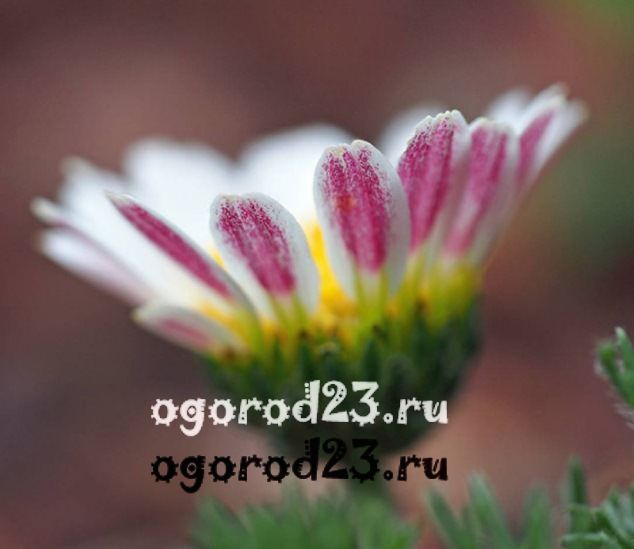
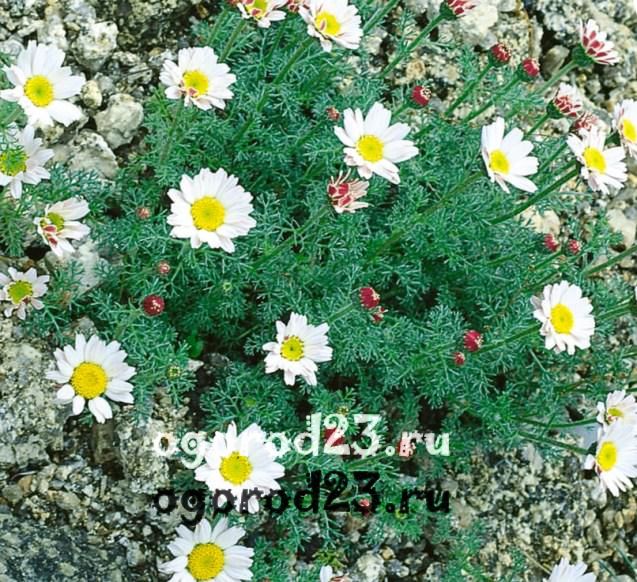
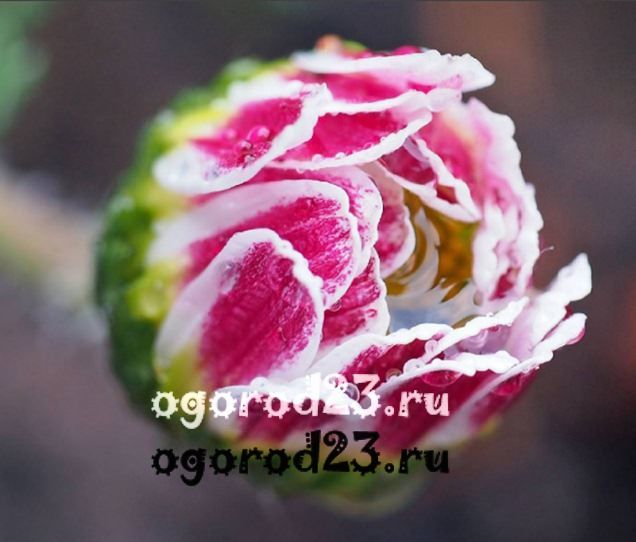
Gerbera
The general structure of the gerbera resembles a daisy, but unlike the “classic” white and yellow color, it can be pink, dark cherry, scarlet, orange, cream, completely yellow or lilac.
It is certainly attractive in its diversity. Today there are many varieties of this flower. The rich color range of gerbera shades and enviable vitality (retains freshness for a very long time after cutting) makes it a popular bouquet flower.
Gerberas can also be double; their multiple petals, depending on the variety, are tubular, curly or pointed. It can be grown either in open ground, and in room conditions, in pots. It blooms in summer and continues to delight the eye until November. The size of the flowers, as well as the height of the stems, varies depending on the variety. Today there are approximately 100 species of this attractive and unpretentious plant.
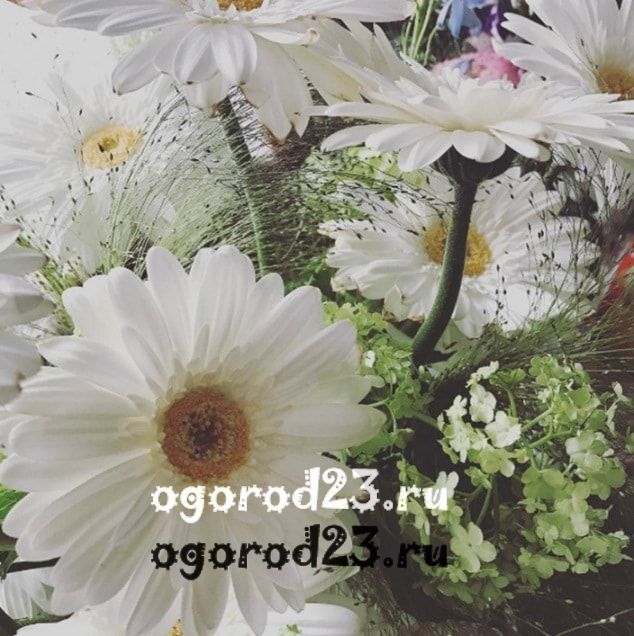
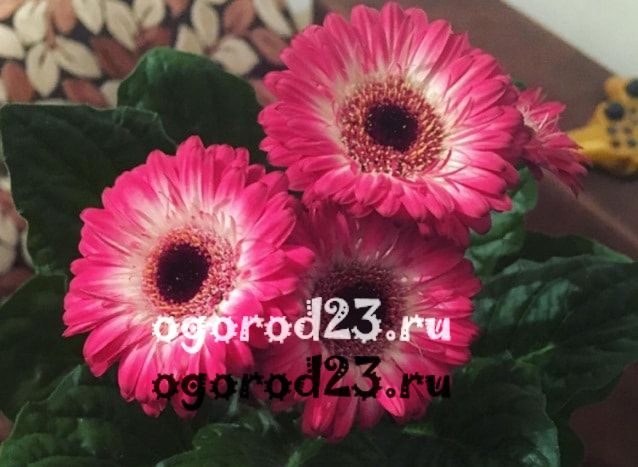

Nivyanyk
In fact, this is meadow chamomile. Nivyanik is the name of the most common variety of this flower representative. Like gerbera, cornflower can have different shapes: double, with needle-like petals, with large or small inflorescences. In our country, this plant is most often grown as a perennial, blooms in early summer and continues to produce flowers until late autumn. It is absolutely unpretentious to the soil and place of growth.
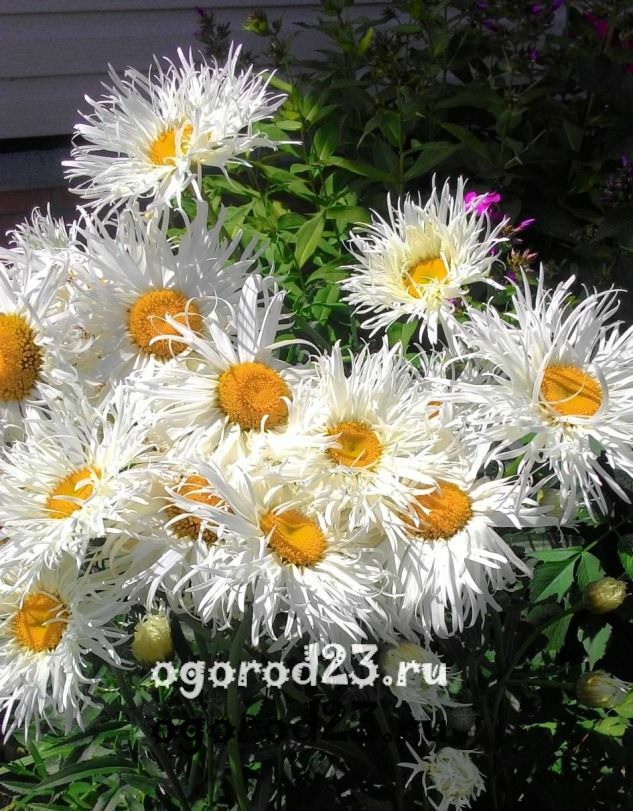

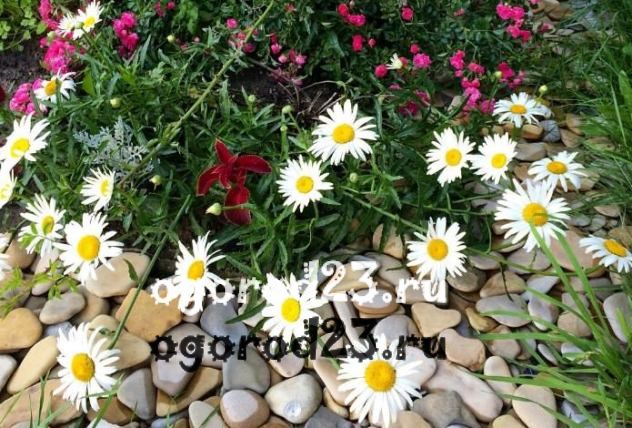
Gatsania
Gatsania comes in all sorts of shades: bright lemon, delicate cream, lilac, rich red, orange, two-color striped, etc. Gatsania is very similar to chamomile, only multi-colored. Coloring can be very diverse. Flowers with gradient colors are very beautiful, when one color smoothly transitions into another. In nature, there are approximately 40 varieties of this flower, all of them are frost-resistant, light-loving, and also resistant to drought and heat. Gatsania blooms at the beginning of summer and continues to bloom until frost. Its height does not exceed 30-40 cm. The flower can remain fresh in a vase for a long time after cutting. The plant is grown in open ground, in pots, flowerpots, and boxes. It looks harmonious in the company of other flowers in the flowerbed, as well as in single plantings. It is used to decorate paths, borders, and alpine slides.
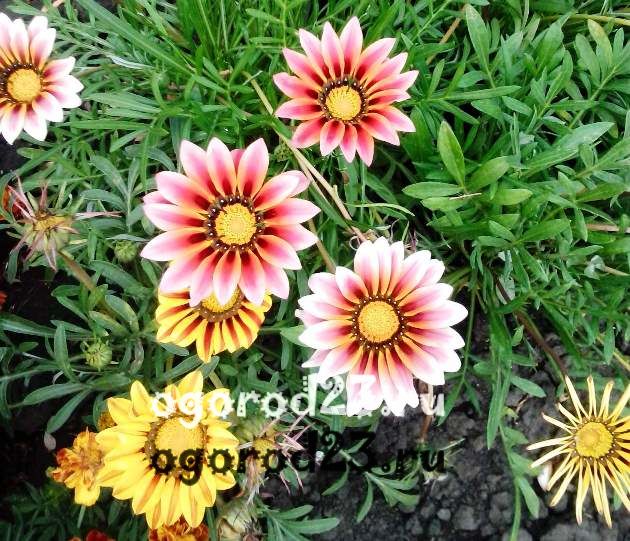

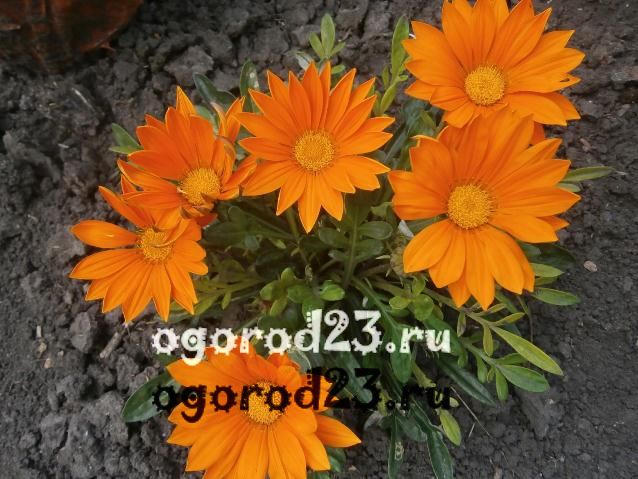
Rudbeckia
This is a tall flower that can reach from 50 cm to 2 m in height (Rudbeckia laciniata - dissected), the size of the inflorescences varies from 9 to 12 cm depending on the variety. Large flowers may have double-colored petals (from darker at the base to lighter at the tips). Rudbeckia also comes in yellow, cream, pink, brownish-scarlet, and orange. This unpretentious plant- a perennial that will feel comfortable in one place for about 5 years. Today there are many species (about 40) and hybrids of this flower. Rudbeckia - decoration autumn flower garden, because its flowering time is in the second half of August and September.
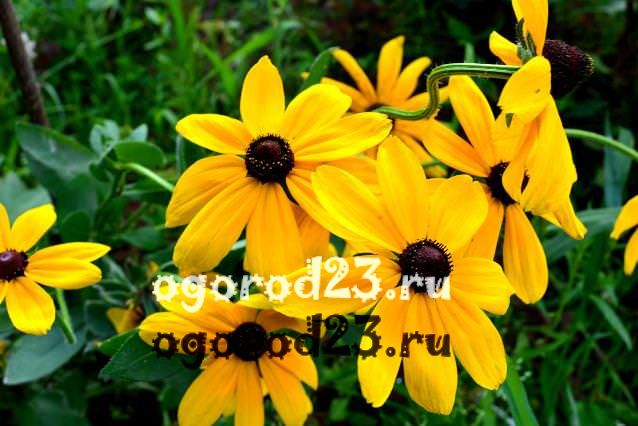
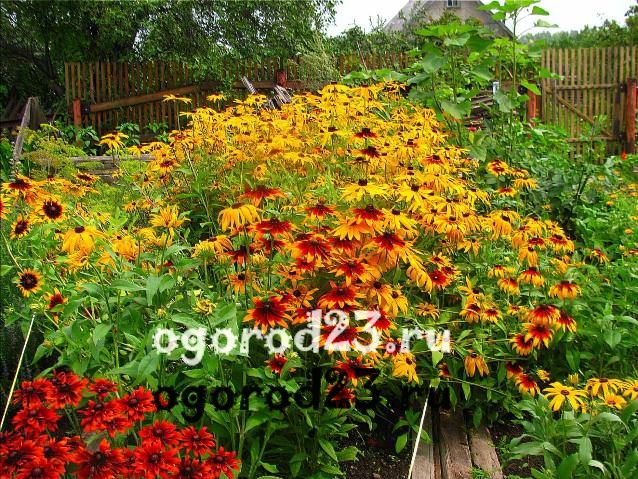
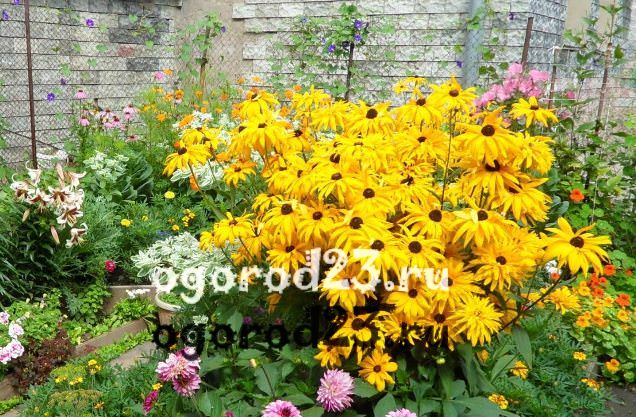
Doronicum
This is an unpretentious, cold-resistant flower that can become a bright decoration of your site with the arrival of May. Doronicum flowering lasts about 1.5 months, but the likelihood that it will delight you with its flowers again in mid-summer or closer to autumn is very high. Its genus consists of 40 varieties, but only 10 of its species are the most popular. Doronicum is also called “kozulnik”. Depending on the variety, it can grow up to 50 cm or 1 m in height. Its flowers are large, from 8 to 10 cm in diameter. If you cut doronicum and put it in a vase, it will last for a very long time without losing its freshness. You should know that this flower is poisonous (its ground part).
One piece of advice: do not plant doronicum (perennial roe grass) under trees - they suppress it, shortening the flowering time.
Doronicum:
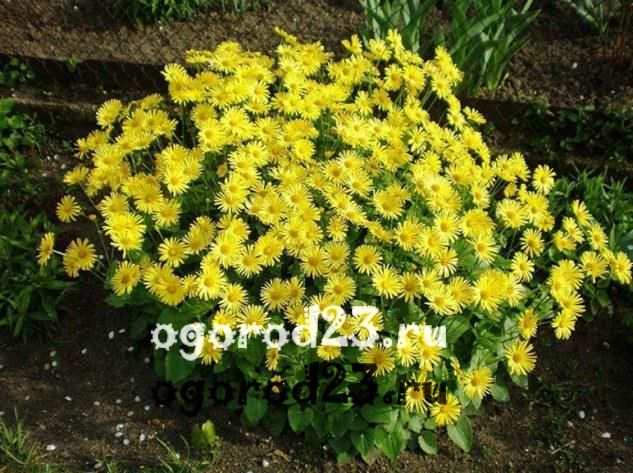
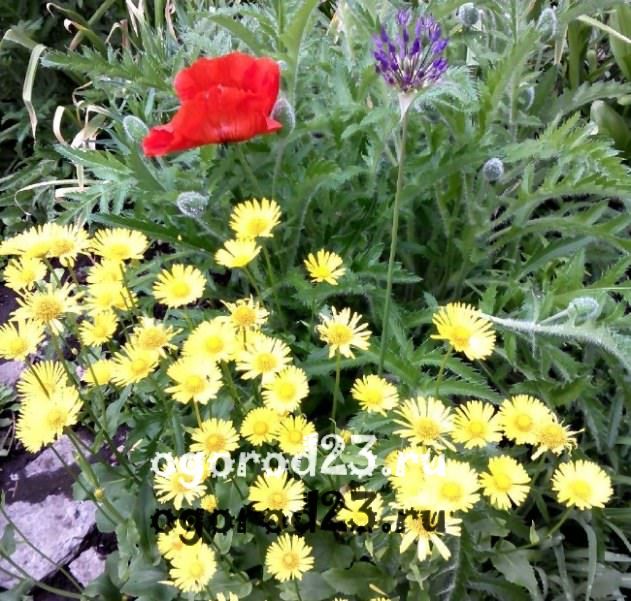
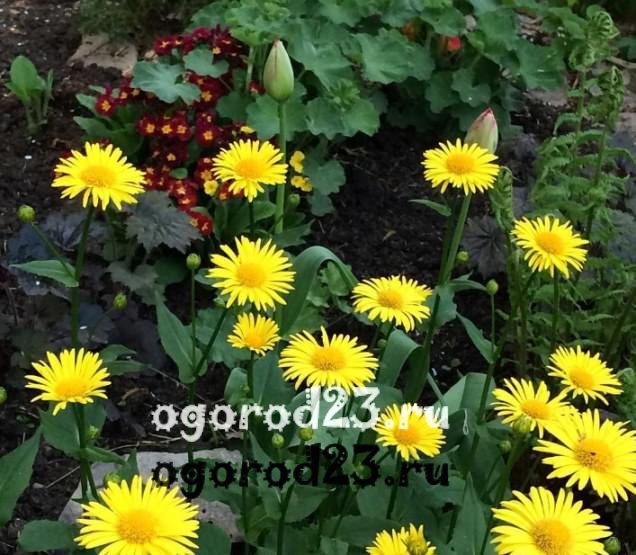
Arctotis
Another name for it is Bear's Ear. Most often found in two types - tall (up to 1 m 20 cm) and short (about 20 cm). Flower petals can be colored white, as well as in red, orange, pink, cream. Colored petals indicate that they belong to hybrids. This plant loves sunny color, its flowers open with the arrival of a new day and close with the onset of evening. Arctotis blooms at the beginning of summer and continues to give you flowers until the onset of the first frost. It is drought-resistant, requires minimal watering, and in general, the flower is unpretentious.
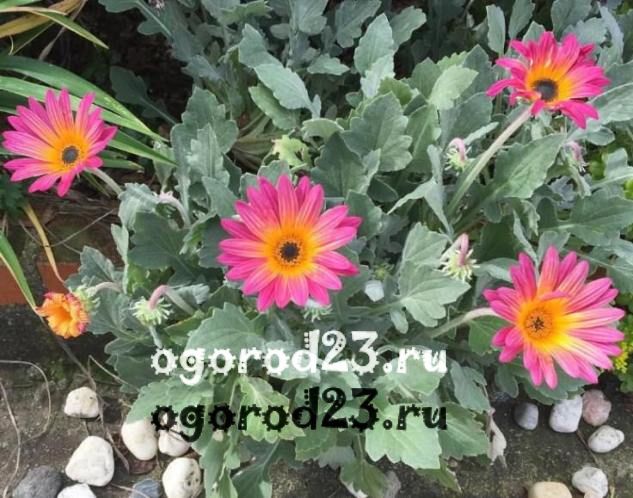

Chrysanthemum Bacardi
This relatively recently bred variety (2004) is often used for making bouquets and various flower arrangements. Chrysanthemums of the Bacardi variety have a yellow center and white petals, which gives them the maximum resemblance to a sunny daisy. In addition to the “classic” colors, flower petals can be yellow, soft purple, red, cream, or pink. The simple structure of the buds gives florists a creative flight of fancy - the inflorescences are painted in different shades, sprinkle with glitter and other small decorations.
This plant looks very attractive both in single plantings and in company with other garden crops. Cut flowers remain fresh for a long time; Bacardi can also be grown indoors, in a pot. Before planting a chrysanthemum in open ground, you should select sunlit areas for it in advance, since if there is insufficient lighting, it may not produce flowers. Watering should be plentiful, but there should be no excess moisture.
Chrysanthemum Bacardi:
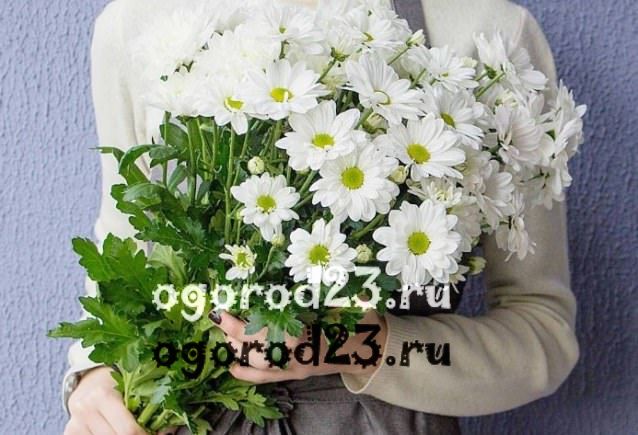
Daisies
This is another flower that looks like a daisy. A particularly pronounced similarity is observed in the variety with a yellow core and white petals. Naturally, this is not the only option for the natural color of daisies; they can be bright crimson, red, lilac, orange, deep yellow, etc. The buds can be different sizes and shapes. This flower itself is not tall, blooms early spring, blooms before frost. Despite its external fragility, it is quite hardy and not capricious. The daisy will look appropriate everywhere: in a single planting, as an element alpine slide, as a decoration for a path, in company with other flowers, as a potted plant. It is noteworthy that the daisy is an indispensable element in the composition of the flower-herbal mixture of the Moorish lawn.
Daisy, photo:
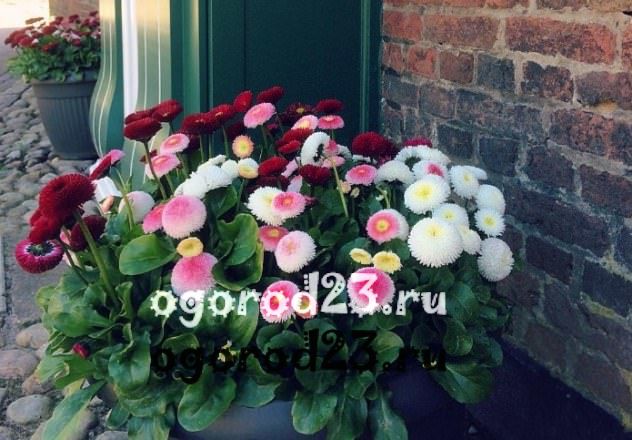

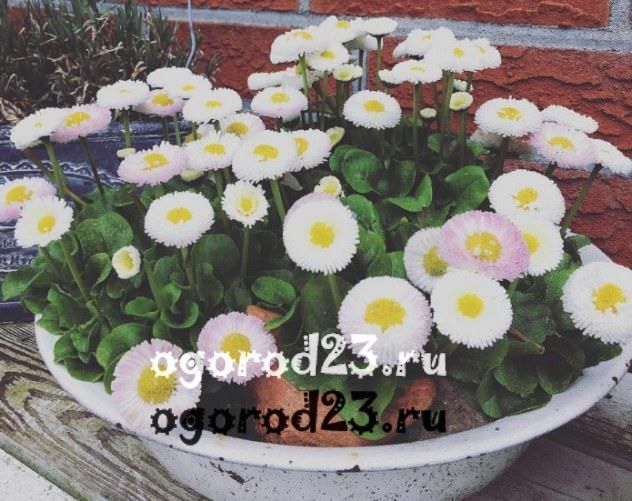
Cosmea
Bright, delicate cosmos flowers tend to self-sow. They are associated with summer warmth, are surprisingly unpretentious and beautiful precisely because of their charming simplicity. Cosmos can be found everywhere: in flower beds, in parks, on city lawns. Lush green carpet with multi-colored flowers will decorate your area, fill bald spots, for example, near a fence, if you decide to sow it. It is not afraid of drought and heat, is resistant to cold, and is undemanding to the composition of the soil. Today there are approximately 25 different types of this elegant flower. Pink, white, deep red, pale lilac buds are crowned with erect stems that reach from 70 to 1 m 50 cm in height. Cosmea is good on its own and in company with other flowers. If you have “empty” places in your flowerbed, plant cosmos there; it will quickly and efficiently hide all the “flaws” and highlight other garden representatives with its presence.
Pyrethrum
The flower is very similar to chamomile. It is even called Dalmatian chamomile. Outwardly, it is very similar to cornflower, only its petals are pink. This flower is a perennial. Once you plant it, you will admire it for many years. Pyrethrum is medium-sized, reaches a height of about 50 cm, is unpretentious, the only thing is that it does not like waterlogging. Pyrethrum flowers bloom in May and bloom long and profusely.

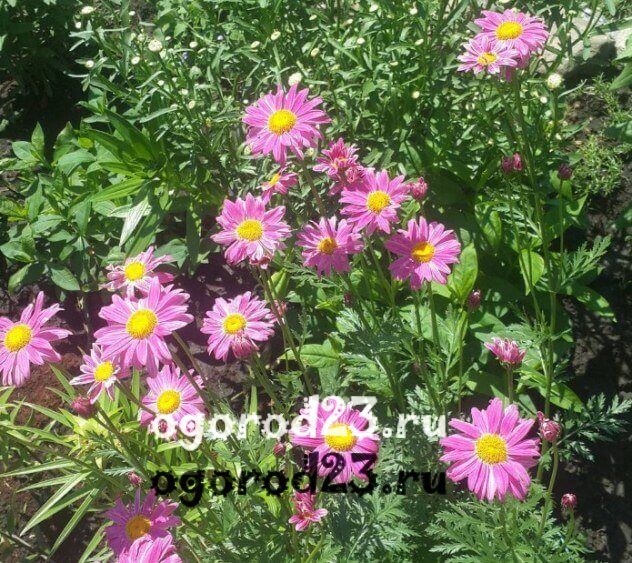
All the plants described above are only a small part of the representatives of the green world, which in their structure and bud shape resemble chamomile. Echinacea, ursinia, helichrysum, dimorphotheca, zinnias (majors), some varieties of dahlias, asters and many others can easily add to this list. At the same time, breeders from all countries continue to work tirelessly to develop new varieties.
Only photos of flowers that resemble a daisy in their shape
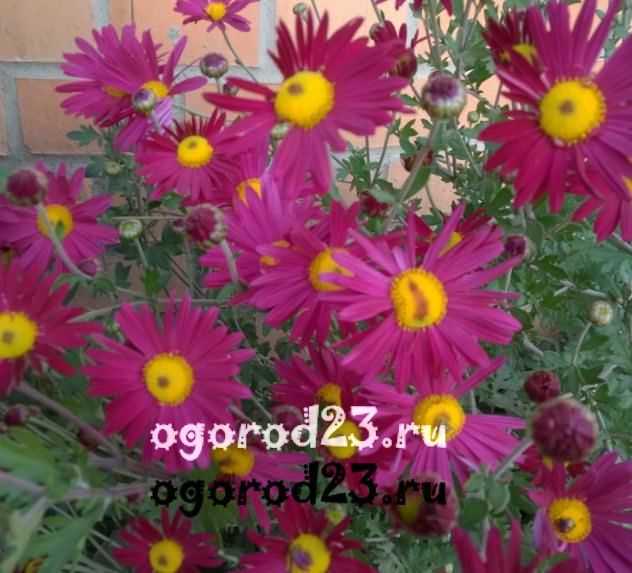 Asters
Asters  Anemone from the ranunculaceae family
Anemone from the ranunculaceae family 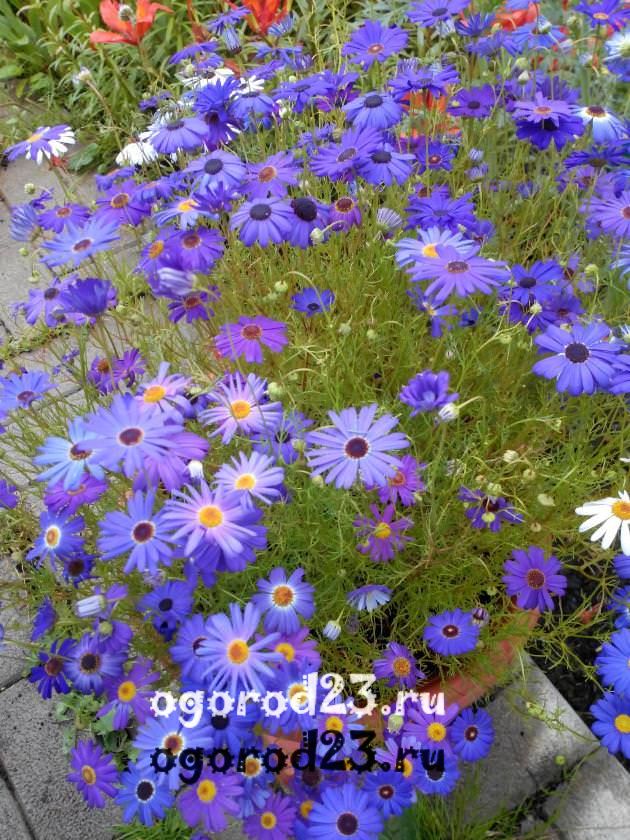 Brachycoma
Brachycoma 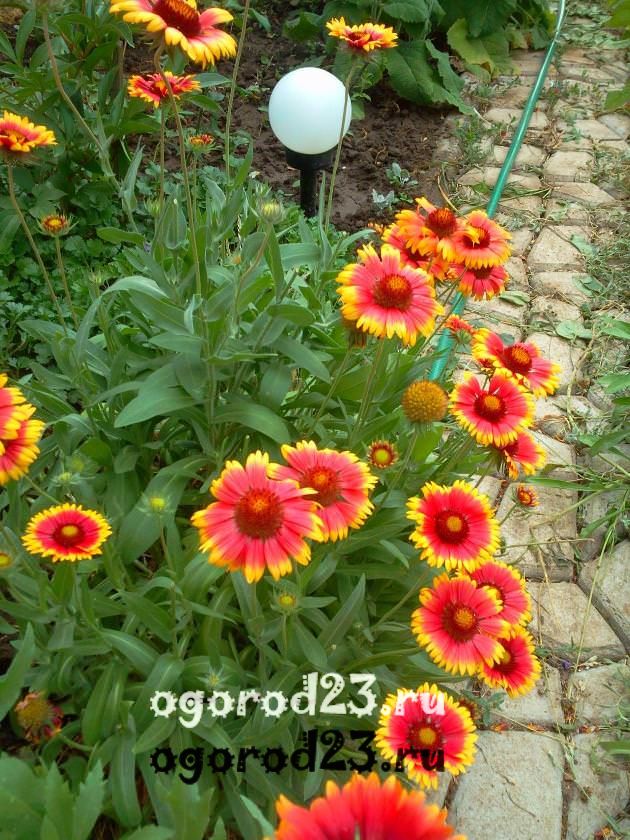 Gaillardia
Gaillardia 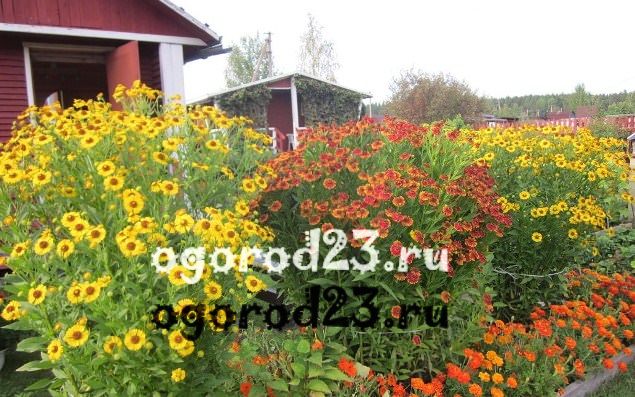 Helenium
Helenium 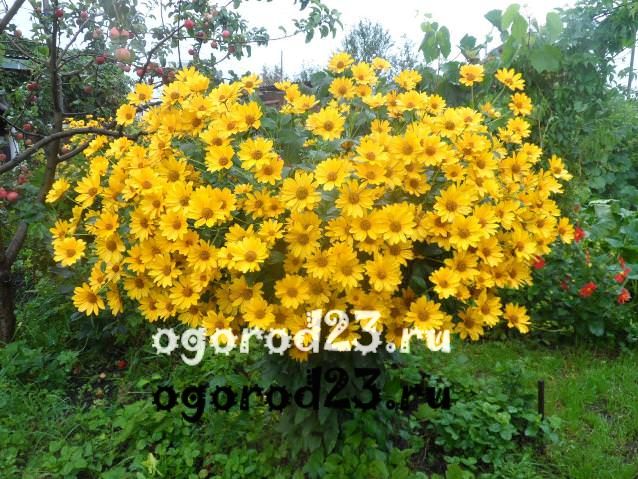 Heleopsis
Heleopsis 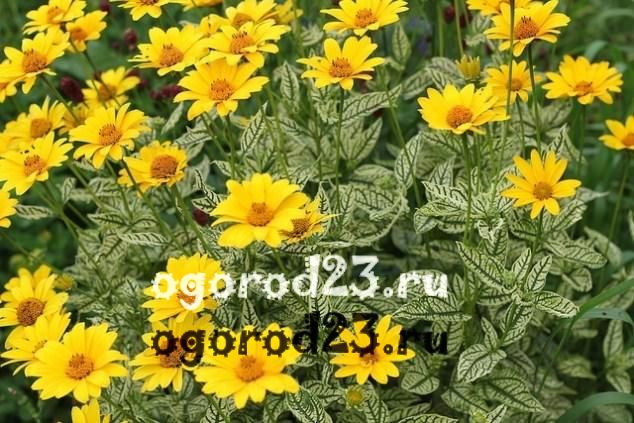 Heleopsis variegated
Heleopsis variegated 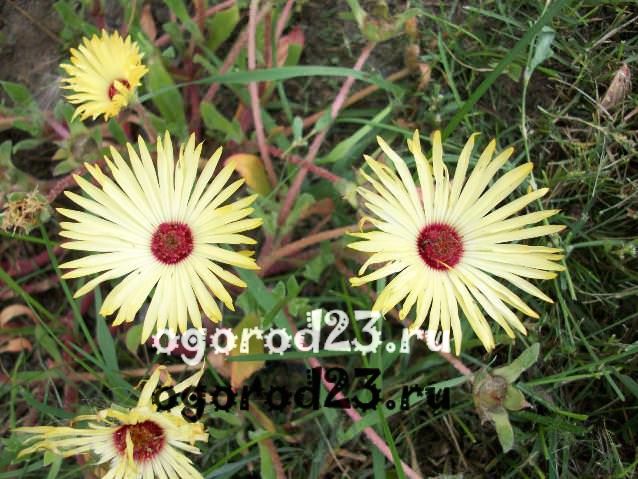 Dorotheanthus
Dorotheanthus 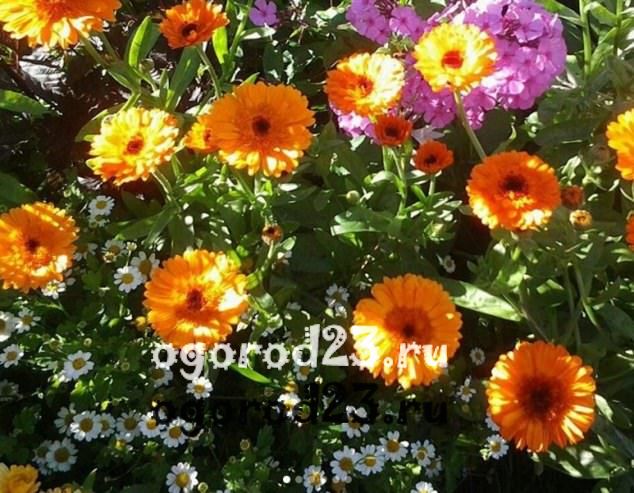 Calendula (marigold)
Calendula (marigold) 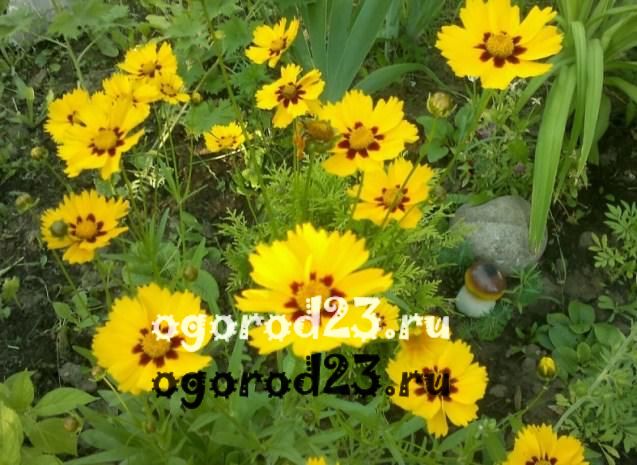 Coreopsis (lenok)
Coreopsis (lenok) 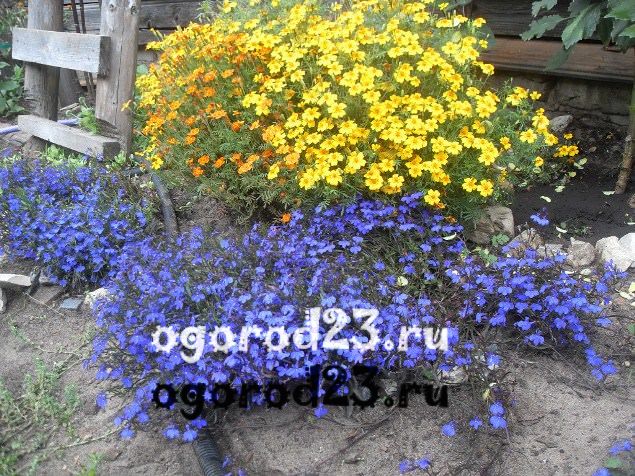 Lobelia ( blue flowers), in the background there are small marigolds
Lobelia ( blue flowers), in the background there are small marigolds 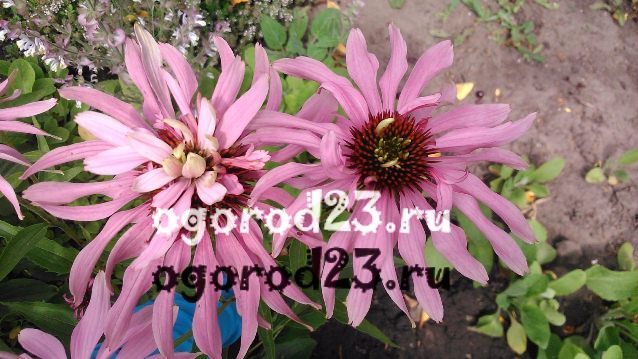 Echinacea Red Riding Hood
Echinacea Red Riding Hood 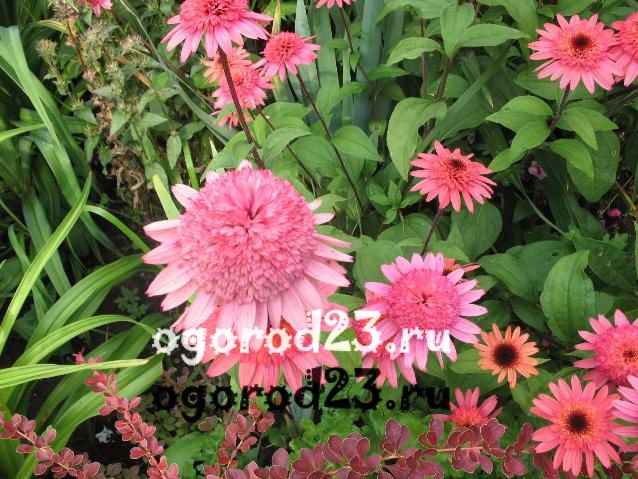 Echinacea
Echinacea 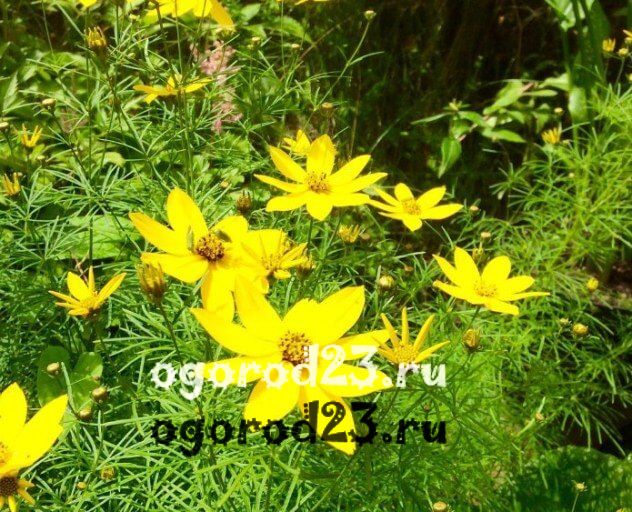 Ursinia
Ursinia 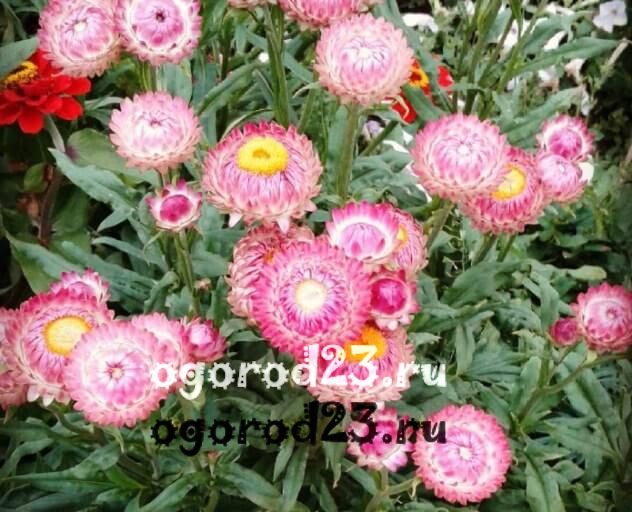 Helichrysum (immortelle)
Helichrysum (immortelle) 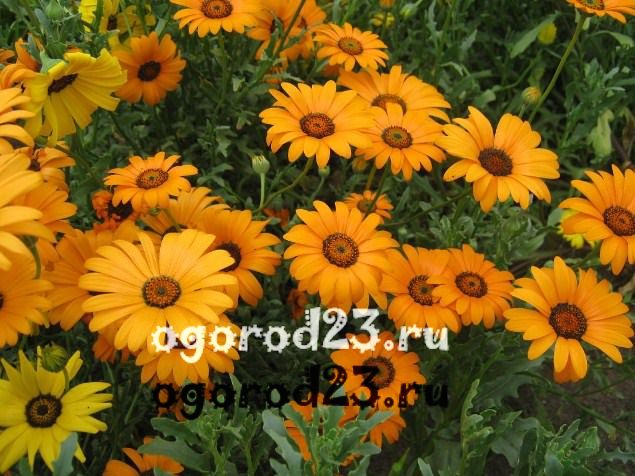 Dimorphotheca notched or orange
Dimorphotheca notched or orange  Dimorphotheca yellow
Dimorphotheca yellow 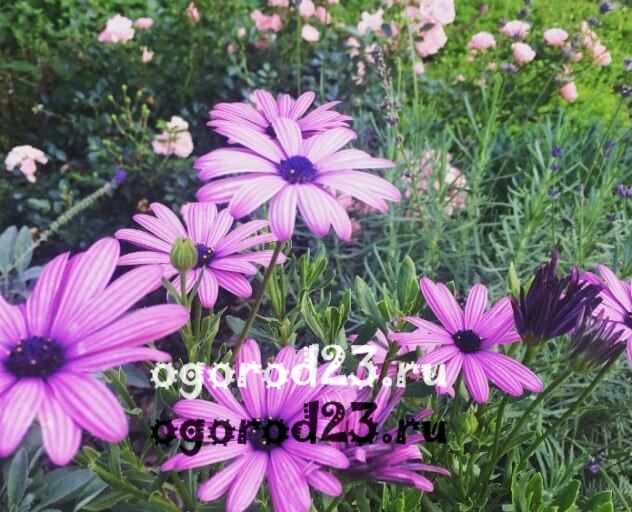 Dimorphotheca hybrida
Dimorphotheca hybrida Look, study, choose - and you will definitely find “your” flowers that look like daisies!
Garden chamomile belongs to the category of perennials. herbaceous plants. It is characterized by ease of care, which allows it to be grown in any area
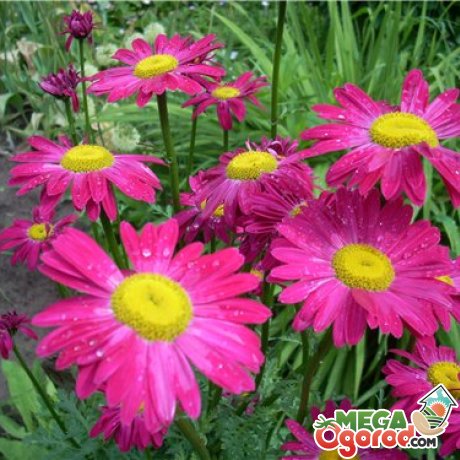
For successful cultivation garden chamomile, it is initially necessary to select the correct variety:
- The most popular variety is the Princess garden chamomile. It has large flowers, the diameter of which can be from 10 to 12 centimeters. In one place this plant stays up to 4 years. The flowers of this chamomile are very often used to make bouquets.
- Chamomile Alaska belongs to the category large-flowered plants. Its heads reach 12 centimeters in diameter. This plant reaches a height of up to 90 centimeters. This variety is characterized by unpretentiousness and drought resistance. It begins to bloom in July August. This plant can be planted in the fall, and next summer it will already bloom.
- The garden chamomile variety Silver Princess is characterized by the presence of snow-white flowers, the diameter of which is 10 centimeters. Plant height is up to 30 centimeters. This variety is very often used in group plantings. Flowering of this plant begins in July and continues until frost.
- The Winner chamomile variety is quite popular, as it has very beautiful inflorescences. The height of the flowers is from 50 to 90 centimeters, and their diameter is from 8 to 12 centimeters. This variety is characterized by the presence of snow-white petals. This plant grows for 4 years without requiring replanting or dividing the bush. This variety is capable of blooming only in the second year after planting. This garden chamomile blooms from June to August.
Today there is huge amount varieties of garden chamomile, which allows you to choose the most suitable option for the design of sites.
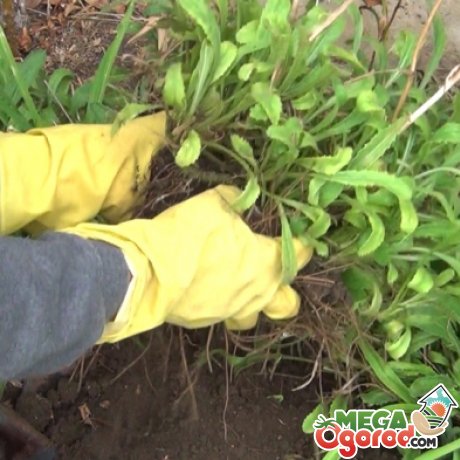
Planting garden chamomile can be done in the following ways:
- Using seeds
- From seedlings
- Dividing the bush
Planting chamomile using any method requires the selection of slightly acidic soils. This plant does not like shade, so it must be planted in sunny places. Before planting, fertilize the soil. If it is acidic, dolomite flour or slaked soda is added. Enough space is allocated for garden chamomile, which makes caring for it much easier. In one place, this plant can grow for up to 5 years.
When planting chamomile garden seeds you need to choose a sunny place. Seeds should be planted directly into the ground in late May - early June.
Garden chamomile has very small seeds, so in order for them to germinate quickly, they must be sprinkled with a very thin layer of soil. After germination, chamomile needs to be provided regular watering. After 4-5 leaves appear on the plant, it needs to be planted with 2-3 flowers. Planting chamomile seeds can also be done in autumn period.
When planting this plant in the spring, you must:
- So that the air temperature is from 16 to 18 degrees.
- In order for the seeds to germinate faster, garden chamomile must be sown under a covering material.
- This plant does not like condensation, so as the chamomile grows, it must be thinned out regularly.
- Planting chamomile in the ground should be done on neutral soils. This is explained by the fact that this plant does not tolerate wetlands.
- In order for chamomile to fully grow and develop, it is necessary to add mineral fertilizers to the soil before planting it.
In order to grow chamomile from seedlings, the seeds are sown in March. For this purpose, it is necessary to take good drainage and pour it into pots. Planting of seeds is done in moist soil. You can sprinkle the seeds with a thin layer of soil or not at all. During a dive, you can use ordinary plastic cups. In these containers it is necessary to make mandatory hole at the bottom.
After picking the plant, it must be sprinkled with water from a spray bottle on top and covered with film. The film cannot be opened until the first shoots appear. Cups with seedlings are placed in a warm and dark place.
When the first shoots appear, the film is removed from the cup. The cups must be placed on the window, as the seedlings require light.
Seedlings appear 10-14 days after planting. After the threat of frost in May has passed, you can transplant chamomile seedlings into the ground. Planting seedlings. In this case, the distance between the bushes should be from 30 to 40 centimeters.
Another highly effective way to propagate chamomile is by dividing the bush. To do this, you need to dig up a chamomile bush in the spring and divide it into 2-3 new bushes, depending on its size. The division of the bush should be done bare hands so as not to damage the chamomile root system. Next, a hole is dug in the ground, the size of which corresponds to the diameter of the new bush. Mineral fertilizers are applied to the bottom of the hole and covered with a layer of soil. Next, the chamomile is planted in the ground and watered. Absolutely all methods of propagating chamomile are highly effective, which allows the gardener to choose the most suitable option for himself.
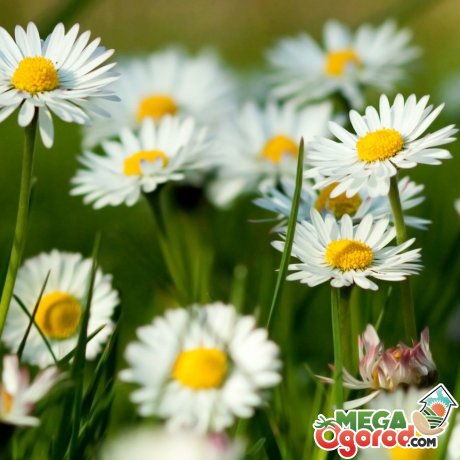
Garden chamomile is a fairly easy-to-care plant. In order for it to fully grow and develop, it needs:
- Ensure timely and abundant watering.
- This plant really does not like weeds, so it needs to be weeded regularly. Weeding will not only help get rid of weeds, but will also allow air to enter the chamomile root system, as well as loosening the soil, since this plant loves fertile soils.
- Seedlings of this plant that are planted in poppy need to be watered and fed frequently. For this purpose, mullein infusion or nitrogen fertilizers can be used.
- Adult bushes of the plant also need feeding. Urea is used for this purpose. It only needs 20 grams per square meter.
- In dry weather, the soil is shed with water after applying fertilizers.
- If the leaves of the garden chamomile begin to acquire a light green color, then it is necessary to re-feed it. The need for repeated feeding arises only if agricultural practices were not followed when caring for and planting the plant.
- Application mineral fertilizers should alternate with the addition of chicken manure, which will limit the possibility of soil acidification, which negatively affects this plant.
Garden chamomile also requires rejuvenation. To do this, five years after planting this plant, the bush must be cut off on one side. Fertile soil is poured into the resulting hole. After three years, the chamomile is rejuvenated, only the root system of the bush is pruned from the other side.
In the autumn, the aboveground part of this plant is pruned.
Garden chamomile is a plant that cannot tolerate too much low temperatures, so it must be covered for the winter. Garden chamomile can be affected by thrips. At the first manifestations of damage, this plant is treated with insecticides.
Growing and caring for garden chamomile is quite simple. That is why any summer resident or gardener can decorate landscape design and without putting in much effort.
More information can be found in the video.
Sparkles of the sun - daisies,
Over the cliff by the river,
I'll pick a bouquet for Natasha,
The one with cornflower eyes.
There is no one more beautiful in the world,
Radiant and sweet.
As if woven from summer,
All made of sunlight
All of happiness and warmth.
Description and features of garden chamomile
Garden chamomile- This is a perennial plant that has long been loved by all gardeners. Yours name garden chamomile received thanks to the word “Romana” translated from Latin means Roman.
In ancient books it was called “Roman chamomile”. IN ancient Egypt It was believed that the sun god created chamomile. People in the old days used to say that chamomile grows in the place where a star fell.
Chamomile is considered popular flower, which grows in the garden, forest and meadows. Slavic girls they wove wreaths from this plant, told fortunes about a guy, or simply collected bouquets. To this day, girls trust chamomile with their deepest secrets and ask her the same question: “does she love you or doesn’t she love her?”
Chamomile is considered the national flower of Russia. After all, only Russian girls wore Russian folk dress with a wreath of daisies on their heads or wove them into their braids. Russian artists often depict Russian fields of daisies in their paintings. Songs are sung about daisies, poets dedicate their poems to them.
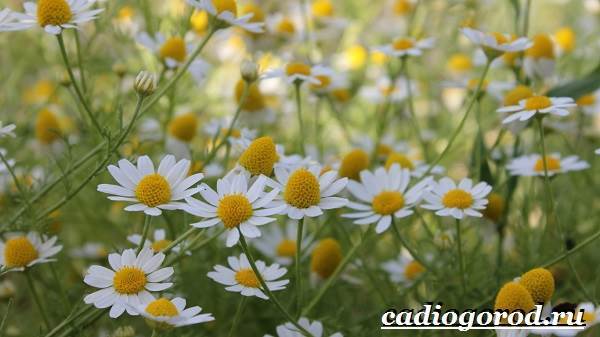
In the photo there is a garden chamomile
Photo of garden chamomile can once again prove her natural beauty. Chamomile is not capricious to planting and growing conditions. She is ready to delight with her beauty all summer. Chamomile is popularly called princess. And this is true, she is like a gentle, graceful princess with a light and pleasant trail of aroma.
Chamomile garden princess belongs to the group of aster plants. It can reach up to 100 cm in height. Chamomile flowers can be various sizes, with an average diameter of 15 cm.
The size depends on the variety. Beautiful, snow-white petals adorn the yellow and bright core, like the sun. Each flower can be placed different quantities petals.
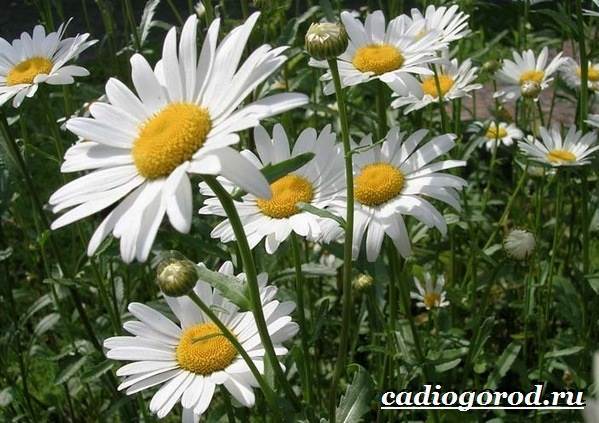
Varieties of daisies
North Star- a perennial garden chamomile that appeals to all gardeners. Easy to grow and care for. It reaches a height of 70 cm. This variety loves the sun's rays and tolerates dry weather. They can be planted at any time, both in spring and autumn.
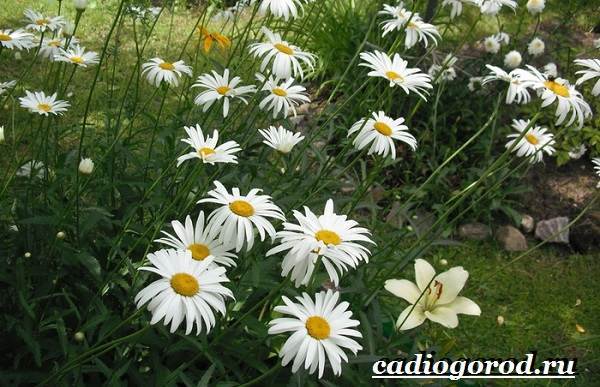
In the photo there is a garden chamomile northern star
garden princess– This species grows up to 35 cm. The flowers are large, reaching up to 10 cm in diameter. The plant is light-loving, loves good, fertile soil. You definitely need to feed them. It is better to plant where the flowers will be protected from the wind. They grow into a large and lush bush.
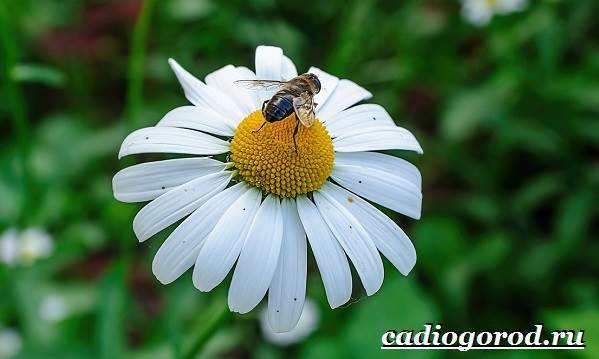
In the photo there is a garden princess daisy
Nivyanyk- this is the most large garden chamomile. Flowers reach up to 15 cm in diameter. They reach a height of up to 80 cm. Large, yellow core and large, flat, white petals. Reproduction occurs most often by seeds or by dividing the bush.
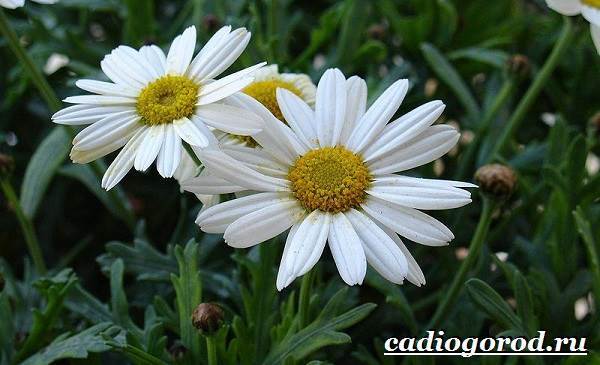
In the photo there is a garden chamomile
Planting and propagation of garden chamomile
Plant chamomile on personal plot or a flowerbed, even a beginner can do it. She is not at all whimsical and not demanding of soil and further care. Those who want to get flowering in the first year of life are recommended to choose the planting method by dividing the mother bush, and for those who are in no hurry, the seed planting method is suitable.
Grow garden chamomile possible from seeds. It is recommended to sow seeds in mid-May. The seeds are sown in open ground at a distance of 25 cm from each other, 30 cm deep, lightly sprinkled with soil.
The desired temperature for sowing is +15 degrees. After the first shoots they can be transplanted to permanent place residence. In the first year of life, the plant will only gain strength and the flowering period may not occur.

Garden chamomile seeds
Garden chamomile seeds You can also plant them in boxes or containers in early March, cover them tightly with film and place them in a lighted place. The seed begins to sprout after 3 weeks.
When the first, young leaves appear, the seedlings are planted in separate containers. Chamomiles should be planted in open ground after the last night frosts, when the weather returns to normal. In this case, chamomile flowering may begin at the end of the summer season, depending on the soil and climatic conditions.
At the end of flowering, the chamomile drops its petals, and in its core the seeds begin to ripen, which are subsequently used for reproduction. Often, a ripe chamomile seed is spread by the wind or birds; when the seeds fall into the ground, they take root, germinate, and in the future they may suddenly delight you with their flowering. There are two main methods of propagating chamomile: by seed and by dividing the mother bush.
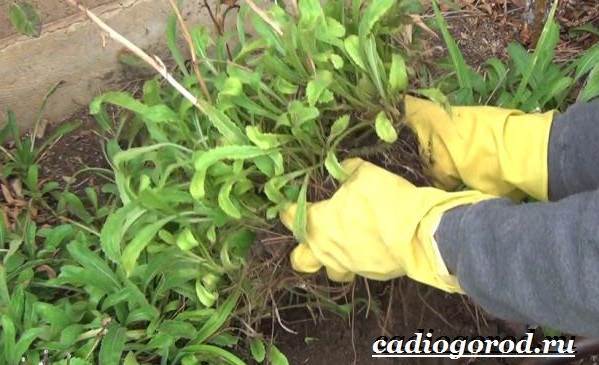
Reproduction of garden chamomile by dividing the bush
It is very useful to propagate chamomile by dividing the mother bush. This simple operation is performed in early autumn or late summer. Carefully, so as not to damage the root system as much as possible, you need to divide the bush with a sharp shovel, entirely with roots. Then the dug up bush is planted in a new place, and fertile and nutritious soil is added to the old one.
On next year The newly planted chamomile is ready to bloom. The bush is considered ready for division when it reaches 3-4 years of age. Attention! If you divide an adult bush every year, the plant will produce beautiful and large ones. In the absence of a rejuvenation procedure, the flowers become smaller.
Caring for garden chamomile
Despite the fact that garden chamomile is not a whimsical flower, but like all living things, it requires competent care. The first condition is to choose the right place to plant chamomile; it should be as sunny and windless as possible.

Watering. Moisture important factor for any plant. On hot days, the plant needs abundant watering. The most important thing is not to overwater the flower. In this case, the roots can rot and this can lead to various diseases or even to the death of the chamomile;
Nutrition. Chamomile loves to be fertilized with mineral and organic fertilizers. Timely feeding is a guarantee abundant flowering.
Soil cultivation. Don’t be lazy about weeding the soil and loosening it in a timely manner. Loosening allows the root system to receive sufficient oxygen.
Rejuvenation. Rejuvenating means separating a little bush and replanting it in a new place. Wherever there is an empty space, you need to fill it with soil (preferably fertile). Every 5 years it is recommended to rejuvenate the flowers.
Perennial garden daisies are frost-resistant plant and tolerate harsh Russian winters well without additional shelter. However, there were cases when in the spring the flower did not come to life after cold weather.
Therefore, a small cover of chamomile will not harm, for example, with fallen leaves, spruce branches or dry sawdust. At the end of autumn, the beautiful chamomile bush is pruned, but not to the very root, but to the first leafy rosettes. In this state, she goes to winter and gain strength for the next flowering season.
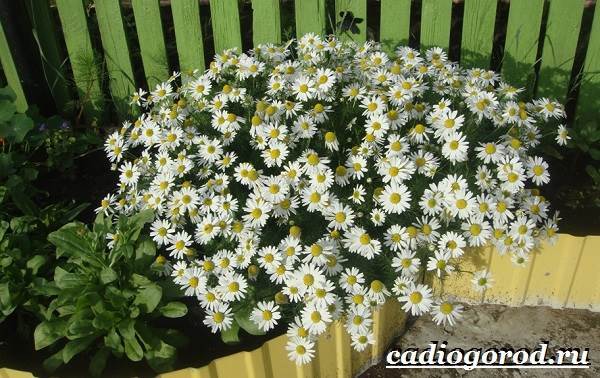
Diseases of garden chamomile and pests that cause them
Frequent diseases of garden chamomile are widespread fungal infections: powdery mildew And gray mold. In order to prevent diseases, chamomile flowers must be weeded and loosened in time. If the plant is already sick, it is recommended to spray it with a fungicidal solution.
Pest insects may also like the tasty, green leaves and rhizomes of chamomile. Most often, chamomile is attacked various types aphids and wireworms. To fight them there are folk remedies, for example, a weak solution of table vinegar or an infusion of wormwood.
Garden chamomile price
Buy garden daisies You can do it in an online store or at any flower market. The price for 1 bag of seeds can range from 20 to 35 rubles, depending on the manufacturer and the selected variety. The cost of 1 adult chamomile bush is 250-300 rubles.
Read: 97
There are many different flowers, so similar to the well-known daisies, but they should not be confused with each other
Daisies are flowers that almost everyone loves. But many people call daisies plants that are only very similar to them, but are actually separate species.
Such flowers look great in flower beds, decorate any lawn in parks or squares, can be planted separately, or in combination with other flowers.
We’ll talk about what these plants look like, so similar to everyone’s favorite chamomile, below.
Anacyclus (anacilus)
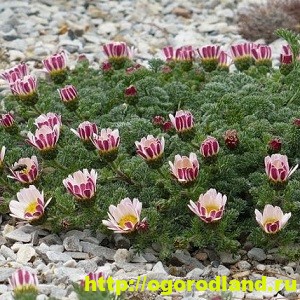
Anacyclus. Chamomile for rock gardens, rockeries, etc.
This plant is so similar to chamomile that they are confused not only by beginning gardeners, but also by many who have been growing flowers for many years. There are more than 8 subspecies of this flower; they can be annuals or perennials. Anacilus usually blooms in the last days of May and blooms until the first ten days of August, so it is readily used for landscaping park areas, flower beds and lawns in public gardens.
Anacyclus belongs to the Aster family and has one peculiarity: with the onset of evening, the flowers close, and with the first rays of the sun they begin to open again. The petals of these species are white on top and pink on the bottom, which is why they differ from daisies. Anaciluses are small in size, creeping along the ground, the pedicels are strong, the flowers can be 4–4.5 cm in diameter.
Doronicum (kozulnik)
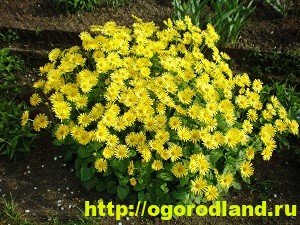
Doronicum
Doronicum is one of those flowers that begins to bloom in the first ten days of May and blooms until mid-June. However, the roe deer often begins to bloom again by the end of July and fades only at the end of September.
His main positive qualities– unpretentiousness and resistance to spring weather changes. In total there are over 37 species of Doronicum, but no more than a dozen of its varieties are popular. This flower can grow from 0.5 to 1 m, depending on the variety. The flowers are quite large - 9 - 11 cm in diameter.
Cut flowers can stay in a vase for 10–14 days without fading. It should be remembered that the above-ground parts of the plant are poisonous. If these flowers are planted under trees, they will grow and bloom poorly there - fruit trees strongly suppress the roe deer.
Nivyanyk
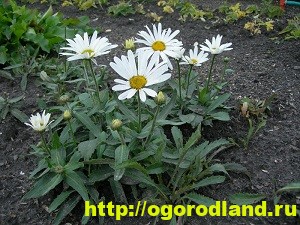
This plant is the meadow daisy that is found everywhere - in the meadow and ravines, at the edge of the forest and on the side of the road. Its most common type is called cornflower. There are many types of it - there are terry ones, with needle-type petals, with large or small flowers. IN different regions In our country, cornflower is grown as a perennial; it begins to bloom in the first ten days of June, and ends flowering at the end of October. Nivyanik is unpretentious to the soil on which it grows and to the place where it grows.
Calendula (marigold)
Calendula is the original pale yellow or rich yellow flowers with a lighter middle (sometimes dark). She has a peculiar aroma, small size flowers are about 5 cm in diameter. Another name for the plant is marigold, so they were nicknamed for the similarity of the plant’s seeds to human nails. Most often on garden plots a medicinal variety of calendula is grown, but later marigolds began to be planted and how ornamental plant. Calendula reproduces mainly by self-sowing.
Daisy
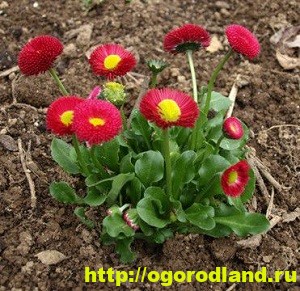
Daisy
The daisy is another flower that is often mistaken for small daisies. Particularly similar are varieties of daisies with white petals and a yellow center. However, the petals of this flower can be of different colors: red, lilac, bright yellow and some others.
The flower is no different large sizes, the first buds bloom already in May, and daisies continue to bloom almost until frost.
Although daisies look delicate and fragile, they are unpretentious, hardy and can grow almost anywhere. It is this flower that is included in
composition of the flower mixture of the Moorish lawn.
Pyrethrum
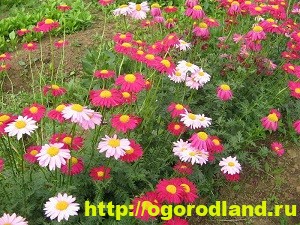
Pyrethrum
Pyrethrum is unusually similar to chamomile in the shape of its flowers and foliage. It is distinguished only by the color of the petals - soft pink.
This plant is a perennial, and once planted in a flower garden, you can enjoy its flowering year after year. Moreover, its flowering begins at the end of spring and continues almost all summer.
Pyrethrum is unpretentious, grows almost everywhere, but it doesn’t like large quantity moisture in the soil.
Arctotis
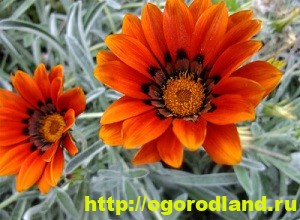
Arctotis
The second name of arctotis is Bear's ear. There are two varieties of the plant - tall (about 1.10 m in height) and low-growing (0.20 cm in height).
Bear's Ear petals can be white, red, yellow, cream, or pink. The color of arctotis indicates that this is a hybrid species.
This flower loves sunlight, the petals of its flowers open at sunrise and close again at sunset. Arctotis is resistant to periods of drought, does not require large amounts of moisture, and is resistant to cold snaps.
Gatsania
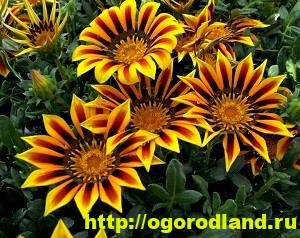
This flower amazes with the variety of colors of its petals. They can be one-color or two-color, often one shade smoothly transitions into another, and colors range from lemon to red and lilac.
There are more than 35 varieties of gatsaniya, and all of them are frost-resistant, love sunlight, and are resistant to heat and dry seasons.
It is used to decorate lawns and borders, and can be grown in flowerpots and boxes. It grows either side by side with other flowers or alone.
Gerbera
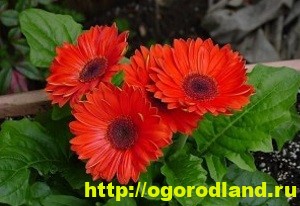
In its structure, gerbera is more similar to chamomile than others, both in the structure of the flower and in size. Gerbera is distinguished by the varied colors of its petals. It can be pink, cherry, scarlet, orange, cream, bright yellow, lilac.
There are many different types gerberas, as well as shades, so florists readily use it when composing a wide variety of compositions. In addition, it retains its original freshness for a very long time after cutting (up to 2
weeks).
Meet terry species gerberas, and they can be grown in open ground, at home, on the balcony. They bloom in early July and continue flowering almost until the cold weather.
Venidium
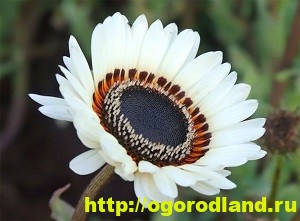
Venidium
This is very original flower, very similar to chamomile. Large baskets with a diameter of about 9 - 12 cm have white or yellow-orange petals, at the base of which there are purple strokes with a black tint, and the middle of the flower consists of small black tubular-shaped flowers.
These are very original annuals that will perfectly complement any flower bed or lawn.
Cosmea
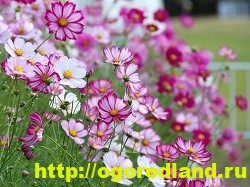
These flowers most often reproduce by self-sowing. It is enough to plant these unpretentious flowers in one place, and in a couple of seasons the cosmos will delight with its flowering throughout the garden plot.
The decorative effect of the vegetative mass and beautiful flowers complement each other perfectly. These flowers can be planted anywhere in the garden or park, and they will actively grow and bloom.
There are more than 20 types of cosmos, and the color of their petals can be white, red, or soft purple.
Ursinia
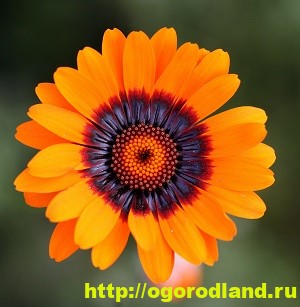
This is a little-known plant species that is extremely similar to chamomile. The most popular variety is Ursinia umbilicalis (dill) - small bushes up to 45 cm high that actively grow in different directions.
Flowers orange color With dark core and red streaks around the center.
The second name - dill - ursinia received for its leaves, similar in shape to the uncut thin leaves of dill. Blooms all summer until early September. And the flowers do not close even in cloudy or rainy weather. It grows and blooms best in sunny areas with sandy soil.
Conclusion
There are many different flowers, so similar to the well-known daisies, but they should not be confused with each other.
Great( 8 ) Badly( 1 )
Among garden flowers there are so many types similar to daisies. It is very difficult for an inexperienced gardener to understand their diversity. Below we will look at the most common of them.
Gerbera
is a perennial plant from the Asteraceae family. Valued for long flowering and high decorative value. Flowers at good care reach a size of 16 cm. They are also widely used for cutting.
There are many varieties of this plant, differing in the size and shape of the inflorescences. IN recent years Even terry forms were developed.
The color range of gerberas is very diverse. The color of the reed corollas can be very diverse. There are varieties with white, red and orange petals.
Care
Caring for gerberas is not particularly difficult. Its main requirements are listed below:
- Large quantity sun rays, at midday light shading is necessary.
- Frequent but moderate watering.
- Soils must be selected with a slightly acidic reaction.
- Faded inflorescences must be removed periodically. This stimulates the emergence of new ones.
- During the period of intensive growth, it is necessary to apply complex mineral fertilizer.
Attention! When watering gerberas, be sure to ensure that water does not accumulate in the center of the leaf rosette, as this will lead to rotting of the leaves and death of the entire plant.
yellow daisy
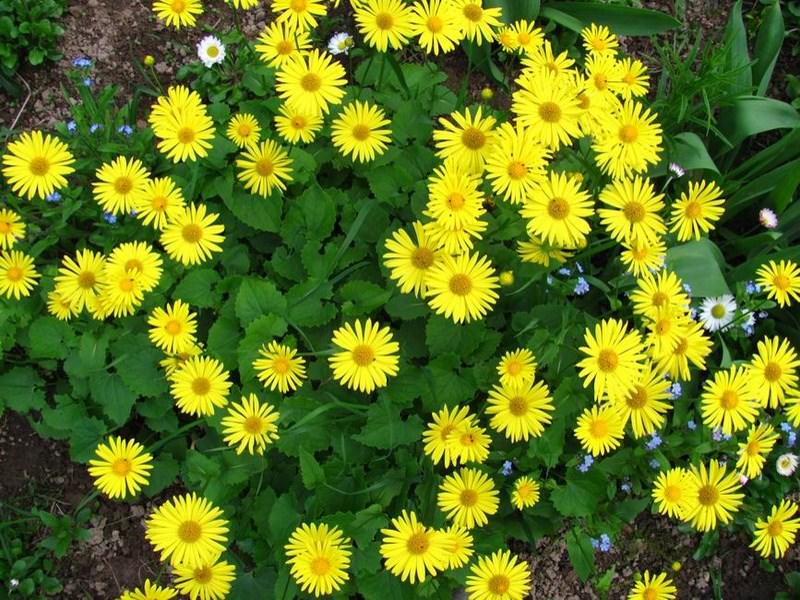
Doronicum
The scientific name of yellow daisy is doronicum. It comes from the Aster family. Doronicum with strong stems that are very resistant to lodging. Their height, depending on the variety, can range from 25 to 70 cm. Lower leaves collected in a basal rosette.
Doronicum inflorescences are baskets of rich yellow. Their size can reach 10 cm. This plant blooms in the spring for 1.5 months, in the shade a little longer.
Care
Doronicum is an unpretentious plant. But for full development, you need to follow a number of simple rules for caring for it:
- Best suited for planting sunny areas, although it can develop successfully in shadier places.
- The soil should be loose, without stagnant moisture.
- In dry and hot weather, watering is required.
- In winters with little snow, additional shelter may be required.
Attention! Root system Doronicum's is superficial, so loosening with this plant is not recommended.
Arctotis
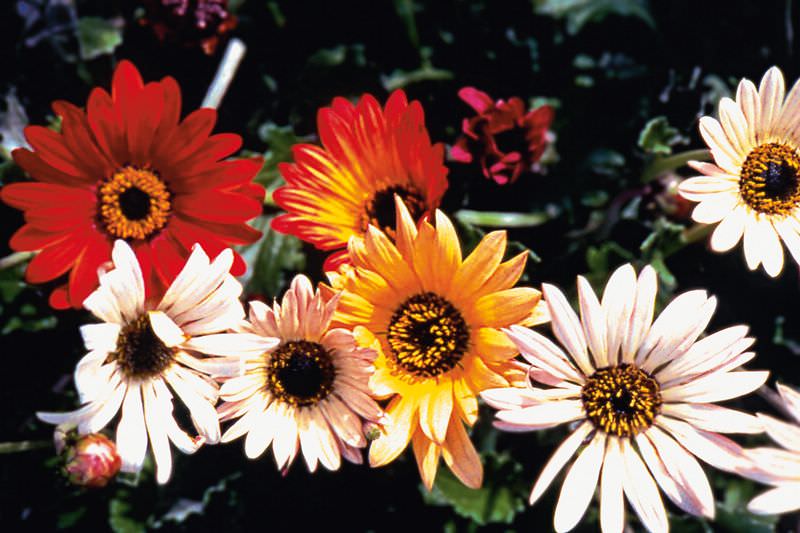
Arctotis
Arctotis is a member of the Asteraceae family. It has massive stems, which, like the leaves, are covered with silvery pubescence, which gives it additional decorativeness. The flowering period lasts from June until frost.
Flowers can be white, orange, red. Their diameter reaches 10 cm. In rainy or cloudy weather they close.
Care
Arctotis, like any other crop, requires compliance with the growing rules for successful growth:
- Watering is minimal, only in very hot weather. It is a drought-resistant species.
- For better tillering, pinching is necessary.
- Faded inflorescences must be periodically removed, which, in turn, stimulates the appearance of new flowers.
Interesting! Arctotis can be grown as a perennial. To do this, the bushes dug up in the fall are transplanted into pots and brought into the house. Where they successfully winter until spring.
Chrysanthemum

Chrysanthemums
Chamomile or, in other words, dendranthem. Characterized by simple chamomile-shaped inflorescences. The number of rows of petals, depending on the variety, can reach from 1 to 4. Flowering occurs in the year of planting. It is characterized by very fast growth and unpretentiousness. The height of the bushes reaches 1 m.
According to the flowering period, they can be divided into early, middle and late. The duration depends on the weather and variety, but on average it is 25-30 days.
Care
In order for the chamomile chrysanthemum to delight with abundant flowering, a number of conditions must be met:
- It is better to choose a sunny location, protected from the winds.
- Watering should be regular and always at the root.
- Overgrown bushes will have to be replanted every 3 years.
- In cold, snowless winters, the chrysanthemum will have to be covered.
Interesting! If you follow the growing rules, up to 50 flowers can open simultaneously on one bush.
Gazania
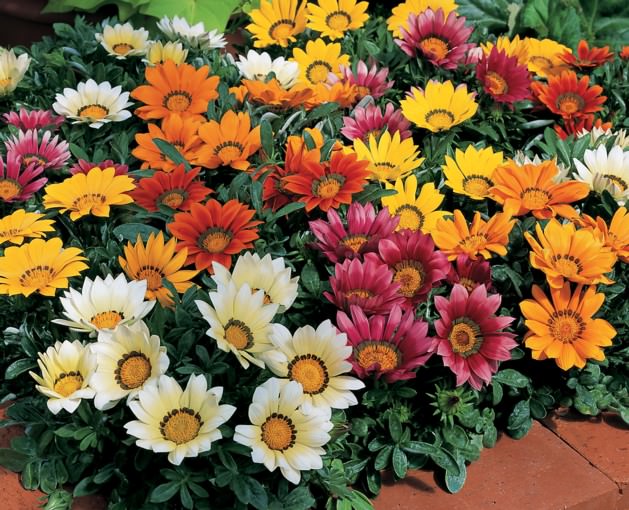
— bright representative Aster family. The plant of this species is of small height, its leaves are collected in a basal rosette. The bottom of the leaf blades are covered with silvery pubescence, which protects the gazania from the cold and helps prevent moisture loss during hot weather.
The flowering period lasts from June until frost. All this time, flower stalks constantly appear from the middle of the rosette.
Gazania inflorescences are baskets with petals of bright, unusual colors. They can be either plain or striped.
Care
For successful growth, development and abundant flowering, you must follow the rules for growing gazania:
- The location is sunny.
- Moderate watering is required. Prolonged waterlogging is detrimental.
- The soil should be light and fertile with good drainage.
- During the season it is necessary to fertilize with fertilizers.
Nivyanyk
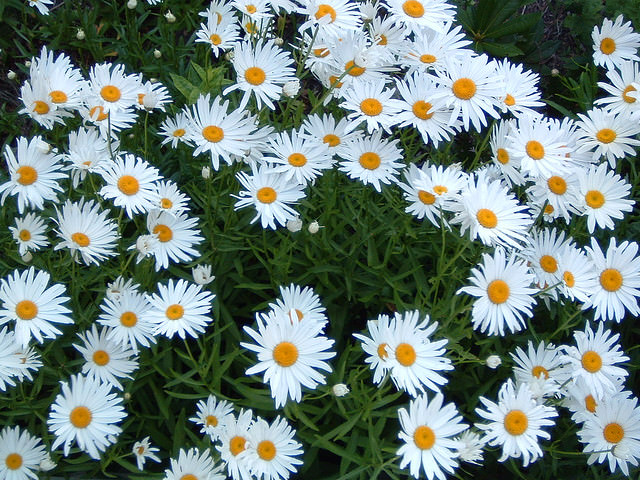
Nivyanyk or garden chamomile- a widespread representative of the aster family. Is perennial plant with erect stems, the height of which, depending on the variety, can reach 1.2 m.
Flowering occurs in 2 periods. The first time in May-June, the second at the end of summer. Flower baskets can reach a size of 10 cm. Cut flowers last up to 10 days.
Care
For successful growth, it requires compliance with some subtleties in cultivation:
- The location should be sunny and open.
- The soil is light and nutritious; sandy and clay soils are not suitable at all.
- Watering is moderate. Excess moisture will lead to an outbreak of fungal diseases.
Attention! For stimulation re-blooming nivaria requires removal of faded peduncles.
Pyrethrum
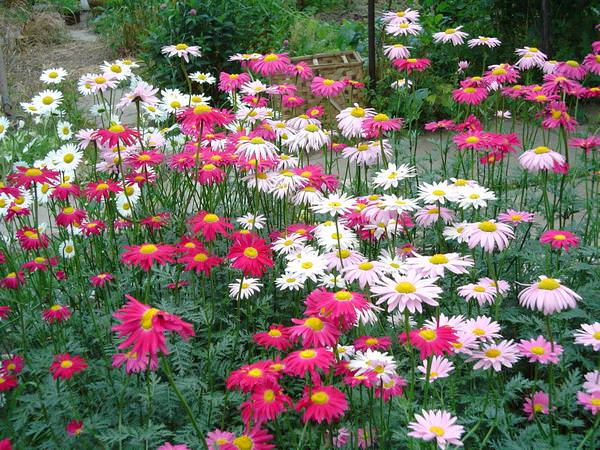
Pyrethrum hybrid
Pyrethrum, aka Persian chamomile, is a plant from the Asteraceae family. Its height can reach 70 cm. The stem of the Persian chamomile is straight with pinnately dissected leaves. It is a herbaceous perennial.
Flowers baskets with petals pink color and a yellow center. The flowering period occurs in mid-summer and favorable conditions can last up to 2 months.
Care
Pyrethrum does not require any special care. The main thing is to comply with the following conditions:
- The site is suitable for both light and light partial shade.
- The soil is loose, especially with good drainage, otherwise the plant will freeze.
- Watering is moderate, only during prolonged drought.
- Plants need to be divided and replanted periodically. This technique will avoid degeneration.
Interesting! Pyrethrum contains a special substance, pyrethrin, which is very poisonous to insects.
Erigeron
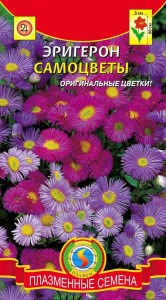
Erigeron
Erigeron or small petal belongs to perennials from the Asteraceae family. Its spherical bushes, consisting of a huge number of branched shoots, can reach a height of 60 cm. The leaves are lanceolate on the bush and more rounded at the base.
Baskets of flowers can be arranged either singly or in several pieces. Flowers can be pink, yellow or various shades of purple. Flowering begins in early summer and continues until late autumn.
Care
Erigeron will not require close attention and care. It is enough to comply with the following conditions:
- The soil must be alkaline, always without stagnant water.
- Choose a site that is sunny and well ventilated.
- Overgrown specimens must be tied up.
Among the variety of garden flowers, daisies occupy a leading position. They fit perfectly into flower beds of the most various types. And if you follow the basic rules of agricultural technology, they will certainly reward you with abundant and long-lasting flowering.

